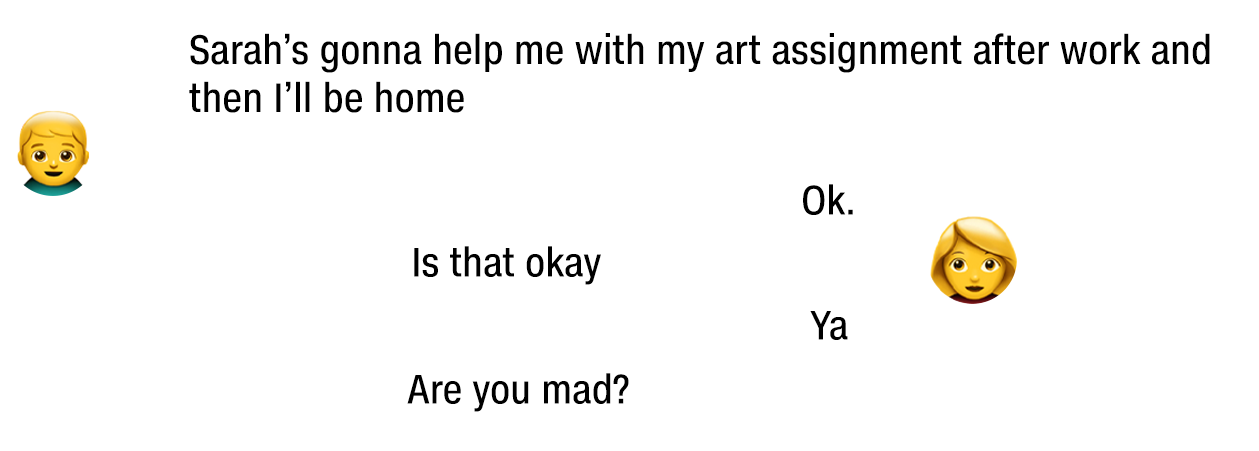How do you pick which emoji to use? Do you worry when you see a period at the end of a text? Are you puzzled by messages from your parents, kids or coworkers?
One reason why: People in different generations often text differently. It’s not an exact science, but interesting theories and trends are emerging as researchers delve into the texts and messages we send.
Take our quiz to see what your texting style says about you, and how well you understand other generations. We’ll give you a few results along the way and a final score at the end.
How would getting a message like this from your boss make you feel?

Your coworker just sent you a hilarious message. How do you respond?


How do you choose which emojis to include in a text?
Gen Z: This generation tends to use and interpret emojis more figuratively or ironically than older generations. A 2022 Adobe study found members of Gen Z were significantly more likely to agree they used emoji differently than their intended meanings.
Millennials: This generation is more likely to use emoji to convey emotions, but sometimes attaches more symbolic meanings to them.
Gen X: This generation is generally more practical in their use of technology, and less likely to use emoji.
Baby Boomers: University of Ottawa researchers found this generation was less likely to use emojis and struggled to interpret some emojis, such as 😳. Others found some Baby Boomers used emojis frequently, but were unaware of potential double meanings behind them.
Keep in mind: Researchers say emojis can add important meaning to text messages, which lack the gestures and facial cues you see when talking with someone in person. But the symbols can also be misunderstood. And age isn’t the only factor that can contribute to confusion; culture, gender and evolving emoji meanings also play a role.

There’s a traffic jam and your Uber is running late. Which text would you send?
When writing a text message, how do you use periods?

In what circumstances do you write something in all caps?

Gen Z: A recent analysis by undergraduates at UCLA found “a stronger preference in Gen Z for using messages that convey a stronger or louder tone” by using all-caps. Linguist Deborah Tannen of Georgetown University describes how her younger students use repeated letters in communication, like beginning a message “hiiiiiiiii,” to convey enthusiasm.
Millennials: Like their younger counterparts in Gen Z, this generation tends to avoid ending texts with periods. They’re also more likely to play with punctuation to convey what linguist Gretchen McCulloch calls “typographical tone of voice.”
Gen X: Texters in this oft-overlooked generation are more likely to apply traditional punctuation rules to their messages, as Miami University Management and Leadership Professor Megan Gerhardt noted in a recent LinkedIn post describing her surprise when her Gen Z students pointed out their feelings about seeing periods at the end of texts.
Baby Boomers: This group is more likely to apply the rules of formal letter-writing to their texts. Niki Tonks, a marketing expert who teaches at Weber State University in Utah, says her surveys found Baby Boomers prefer full sentences in text messages and are less likely to understand shifting nuances of punctuation.
Keep in mind: Many of us break rules we’ve learned about grammar and punctuation when we send text messages. Linguist John McWhorter argues that’s because texting is more akin to “written speech” than a formal piece of writing.
How would you feel if a romantic partner responded to a text from you by saying “K” or 👍?

Look at your phone. How many text messages did you send and receive yesterday?

When you send a text message, how quickly do you expect to get a response?

Gen Z: Why send one text when 10 will do? Researchers have found texters in this generation send and receive a greater volume of messages than those in older generations. They’re also likely to expect quicker responses and worry more about delays.
Millennials: Researchers have found this generation generally sends and receive fewer texts than their younger counterparts, but their phones still spend plenty of time buzzing. Millennials send and receive a high volume of messages, and generally expect quick responses.
Gen X: This generation sends a moderate volume of text messages. And unlike their younger counterparts, they worry less about response times. Maybe they’re busy watching the new Brat Pack documentary instead?
Baby Boomers: This generation is getting a lot more conversant in texting, but they’re not quite fluent. Baby Boomers generally send and receive a lower volume of text messages than those in younger generations, and they’re not as concerned about response times.
Keep in mind: Unwritten rules shape the way different generations text each other, and how they feel about the interactions, according to Niki Tonks, a marketing expert who teaches at Weber State University in Utah. But our texting style isn’t set in stone based on our birth year. In fact, we may code-switch when we text, just like many of us do when we speak, adopting tones and approaches that are similar to the person we’re texting with, and adapting our expectations accordingly.
Read this conversation between a Gen Z son and his Gen X mom:

Is the mom mad at her son?
The mom is just trying to be efficient and direct. This text exchange between marketing expert Niki Tonks and her son inspired her research. Her son later explained that he’d been worried she was mad because of her short replies.
What are these generations’ top 5 favorite emojis?
These rankings of favorite emoji came from Adobe’s 2022 U.S. Emoji Trend Report. That survey also found that 74% of Gen Z emoji users say they use emoji differently than their intended meanings, compared to 65% of Millennials, 48% of Gen X respondents and 24% of Baby Boomers.
In 2022, tech company Giphy pointed to the growing use of GIFs by this generation as it asked British regulators not to block a deal for its acquisition by Meta.

“Marketplace commentary and user sentiment towards GIFs on social media shows that they have fallen out of fashion as a content form, with younger users in particular describing GIFs as ‘for boomers’ and ‘cringe,’” Giphy said in an August 2022 filing.
How well do you understand Gen Z?
A recent analysis from UK tech retailer Currys listed these translations. Here’s a quick glossary of the Gen Z terms:
DIFTP This acronym is short for “do it for the plot.” It gained steam on TikTok in 2022.
Slaps This term has its roots in hip-hop and became more mainstream in the late 2010s.
💀 This emoji has come to signify “I’m dead” and is used to convey laughter.
Tea Like many words now known as Gen Z slang, this phrase originated in Black drag culture.
True or false: Millennials were the first generation to popularize smiley faces in text communication as emojis became increasingly popular.

We actually have Baby Boomer Scott Fahlman, an emeritus professor at Carnegie Mellon University, to thank for inventing the emoticon in 1982.
What year were you born?

Here are your full results:
Editors’ Notes
How we did this: We spoke with researchers, read studies and drew upon our own personal experiences to shape the questions in this quiz. Some questions are based on research findings or echo survey questions used in studies. Others were inspired by expert interviews or anecdotal observations.
What's next: We hope this quiz sparks conversation and encourages more research into these important issues. We plan to analyze responses we receive to see how they compare with generational expectations.





